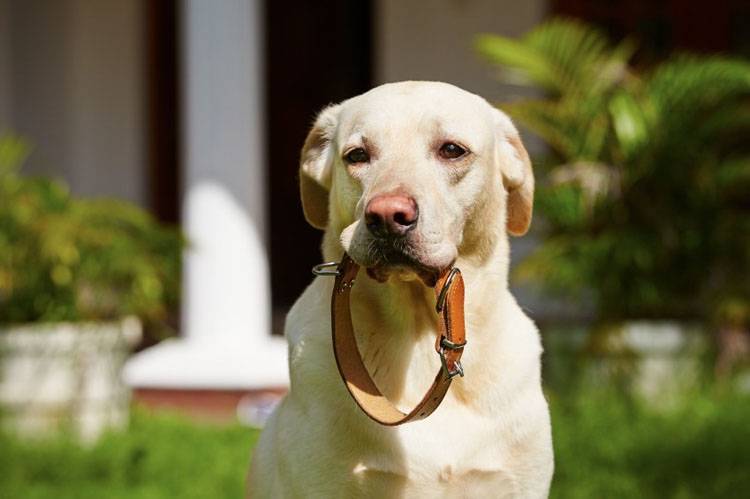Head Collars, Harnesses and Leashes
Have you ever felt puzzled about what type of collar and leash is right for your dog? Well, fear not. Whether he’s a big and goofy Great Dane, a docile and friendly Labrador Retriever, or a feisty but cuddly Pomeranian, there is a leash out there for him. You don’t need to attend a dog training school to know what issues you do or don’t encounter when walking your dog. So here is a guide to what leash will work best for your situation.
Head Collars for Tugging Dogs
For the insistent tugger, your best option is to purchase a head collar. Most people tend to find a head collar daunting, as the general shape makes it seem like a cruel training tool. Plus, dogs have a tendency to be resistant to anything you try to put around their face so a lot of pet owners give up when their dogs reacts negatively to the collar.
However, for a dog who pulls on the leash, a head collar is extremely important for both his safety and health. Your canine can easily injure himself by having the restrictive collar choke him and no owner appreciates being dragged down the street every time he goes for a walk.
RELATED: Dog Walking Etiquette
How to Get Your Dog to Wear a Head Collar
In order to desensitize your dog to the head collar, begin by putting a treat in your hand and holding it in front of the collar so your dog is forced to put his head through the collar to get the reward. Once he puts his face into the collar, give him the treat and reward him with plenty of love and praise. Repeat this until he gets used to the collar.
Your next step will be to put the head collar on him and feed him right afterwards. The collar is not restrictive on his mouth so he’ll be capable of eating while wearing it. Your dog will adjust to the head collar very quickly as long as you follow the steps and exercise plenty of patience with him.
Dog Harnesses for Smaller Breeds
For smaller breeds, harnesses are extremely beneficial for walking. As any dog trainer will tell you, a harness is a great tool to have. A lot of dog owners mistake harnesses as dog training tools to prevent tugging. However, they were actually created to do the opposite. Harnesses are meant to encourage pulling, as they are typically reserved for service dogs who are trained to haul sleds and other heavy equipment.
Yet, a harness can also be used for a small dog. Many owners of small dogs encounter frustration when shopping for collars, as many of them are too big to fit around their tiny necks. This problem is easily solved with the use of a harness, as they are more secure than collars, and small dogs are less likely to slip out of them while on a walk. Using a harness for a small dog is both safer and more comfortable for your pet.
Leashes for Every Dog
Last, but not least, there are leashes. Unlike head collars and harnesses, choosing the right leash is far simpler. Leashes are more a matter of personal preference than a breed-specific tool. You’ll encounter different lengths, styles and materials.
Retractable Leash vs. Standard Leash
Retractable leashes are nice for dog owners who prefer to choose and control the distance of their dog at will. However, keep in mind retractable leashes are definitely not as safe as standard leashes. Should another dog unexpectedly appear while you have your dog at a long lead, you won’t have enough time to retract your leash and something devastating could occur.
If you choose this type of leash, be sure you get a heavy enough grade leash to restrain your dog’s strength and weight. For the most part, the retractable leash is better suited for a leisurely stroll with a dog who doesn’t pull or need any training.
Leash Length
Standard leashes are favorable for those who like having their dogs relatively close to them at all times, or for dogs learning to heel or not pull on the leash. While standard leashes come in a variety of lengths, you can easily determine the longest length you want for your training and walking.
RELATED: Long Line Dog Training
If you aren’t working on any distance or recall training, a basic leash with four feet to six feet of length is plenty. Style wise is completely a personal preference as to where you’re most comfortable holding the handle. However, check for safety when it comes to this. Some leashes claim to have better handling by providing a rubber handle, but when put to the test, these handles can actually slide up the leash and prove to be counterproductive.
Leash Material
The material you choose for the dog leash will most likely be based on cost. However, just about any leash material is safe for your dog. Nylon leashes are typically the least expensive, but some dog owners don’t like the fact you can get a rug burn if you have a dog who pulls severely or needs to be restrained.
You won’t encounter that issue with leather leashes because they’re stronger, but often more costly. Chain leashes are strong as well and not as commonly used, but again, it’s about personal preference. There are also chain and nylon meshed leashes available on the market. Whatever your personal style or preference may be, there are plenty of leashes to choose from.
As long as you choose the right collar to ensure your dog is comfortable and safe, you’ll be on your way to having long and enjoyable walks that both of you can enjoy.





